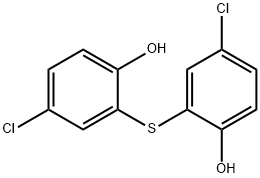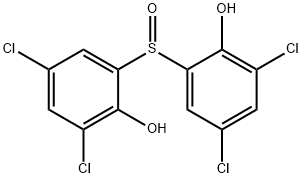BIS(2-HYDROXY-5-CHLOROPHENYL) SULFIDE
- CAS NO.:97-24-5
- Empirical Formula: C12H8Cl2O2S
- Molecular Weight: 287.16
- MDL number: MFCD00031479
- EINECS: 202-568-7
- SAFETY DATA SHEET (SDS)
- Update Date: 2024-12-18 14:07:02

What is BIS(2-HYDROXY-5-CHLOROPHENYL) SULFIDE?
Chemical properties
white to pale yellow powder
Originator
Fenticlor,Shanghai Lansheng
The Uses of BIS(2-HYDROXY-5-CHLOROPHENYL) SULFIDE
Fungicide; especially used against Monosporium apiospermum: Reifferscheid, Seeliger, Dtsch. Med. Wochenschr. 80, 1841, 1850 (1955).
The Uses of BIS(2-HYDROXY-5-CHLOROPHENYL) SULFIDE
Fentichlor is a fungicide especially used against Monosporium apiospermum; topical antifungal and antibacterial agent in hairdressings, antifungal creams, and ointments; thermoplastic resin.
Definition
ChEBI: An aryl sulfide having two 5-chloro-2-hydroxyphenyl groups attached to sulfur; an antiinfective drug mostly used in veterinary medicine.
Preparation
Fenticlor is produced (1) by the reaction of 4-chlorophenol with sulfur dichloride in the presence of AlCl3 or (2) by chlorination of 2,2'-thiobisphenol with chlorine in glacial acetic acid or with SO2Cl2 in dichlorobenzene. It shows a tendency to discoloration. Fenticlor has a broad range of antimicrobial action; it is, e.g., effective against bacteria, fungi, yeasts, and algae. Fenticlor is therefore used as a preservative for aqueous functional fluids and to control algae and slime in process water circulation systems.
Manufacturing Process
1 mol bis(2-hydroxy-phenyl)-sulfide, prepared from sulfuryl chloride and phenol, in about 2500 ml glacial acetic acid was dissolved and heated for
boiling. 2-3 mol gaseous chlorine was passed through that solution and on
cooling bis(2-oxy-5-chlorphenyl)sulfide was fallen. It was recrystallized from
acetic acid or light petroleum. MP: 175°C. A residue was dropped from filtrate
with water as the white crystals, which melted at the same temperature.
Fenticlor may be also prepared by adding sulfuryl chloride to the solution of
bis(2-hydroxy-phenyl)sulfide in dichlorobenzene
Therapeutic Function
Antifungal
General Description
White to cream-colored solid or pale yellow powder. White crystalline solid melting from 175.8-186.8°C. Odorless and insolbule in water.
Air & Water Reactions
Insoluble in water.
Reactivity Profile
BIS(2-HYDROXY-5-CHLOROPHENYL) SULFIDE is incompatible with acids, diazo and azo compounds, halocarbons, isocyanates, aldehydes, alkali metals, nitrides, hydrides, and other strong reducing agents. Reactions with these materials may generate heat and toxic or flammable gases.
Hazard
Toxic by ingestion.
Fire Hazard
Flash point data are not available for BIS(2-HYDROXY-5-CHLOROPHENYL) SULFIDE, but BIS(2-HYDROXY-5-CHLOROPHENYL) SULFIDE is probably combustible.
Properties of BIS(2-HYDROXY-5-CHLOROPHENYL) SULFIDE
| Melting point: | 175°C |
| Boiling point: | 416.7±45.0 °C(Predicted) |
| Density | 1.4186 (estimate) |
| storage temp. | Sealed in dry,Room Temperature |
| form | powder to crystal |
| pka | 7.91±0.48(Predicted) |
| color | White to Orange to Green |
| Merck | 14,4004 |
| Stability: | Stable. Incompatible with strong oxidizing agents. |
| CAS DataBase Reference | 97-24-5(CAS DataBase Reference) |
| EPA Substance Registry System | Fenticlor (97-24-5) |
Safety information for BIS(2-HYDROXY-5-CHLOROPHENYL) SULFIDE
| Signal word | Warning |
| Pictogram(s) |
 Exclamation Mark Irritant GHS07 |
| GHS Hazard Statements |
H315:Skin corrosion/irritation H319:Serious eye damage/eye irritation |
| Precautionary Statement Codes |
P264:Wash hands thoroughly after handling. P264:Wash skin thouroughly after handling. P280:Wear protective gloves/protective clothing/eye protection/face protection. |
Computed Descriptors for BIS(2-HYDROXY-5-CHLOROPHENYL) SULFIDE
New Products
4-Fluorophenylacetic acid 4-Methylphenylacetic acid N-Boc-D-alaninol N-BOC-D/L-ALANINOL Tert-butyl bis(2-chloroethyl)carbamate 3-Morpholino-1-(4-nitrophenyl)-5,6-dihydropyridin- 2(1H)-one Furan-2,5-Dicarboxylic Acid Tropic acid S-2-CHLORO PROPIONIC ACID ETHYL ISOCYANOACETATE 2-Bromo-1,3-Bis(Dimethylamino)Trimethinium Hexafluorophosphate (6-METHYL-[1,3]DITHIOLO[4,5-b]QUINOXALIN-2-ONE INDAZOLE-3-CARBOXYLIC ACID 4-IODO BENZOIC ACID (2-Hydroxyphenyl)acetonitrile 4-Bromopyrazole 5,6-Dimethoxyindanone 2-(Cyanocyclohexyl)acetic acid 4-methoxy-3,5-dinitropyridine 2-aminopropyl benzoate hydrochloride 1-(4-(aminomethyl)benzyl)urea hydrochloride diethyl 2-(2-((tertbutoxycarbonyl)amino) ethyl)malonate tert-butyl 4- (ureidomethyl)benzylcarbamate Ethyl-2-chloro((4-methoxyphenyl)hydrazono)acetateRelated products of tetrahydrofuran


![4-CHLORO-2-((5-CHLORO-2-[(2,6-DICHLOROBENZOYL)OXY]PHENYL)SULFONYL)PHENYL 2,6-DICHLOROBENZOATE](https://img.chemicalbook.in/StructureFile/ChemBookStructure2/GIF/CB2670120.gif)
![4-CHLORO-2-((5-CHLORO-2-[(2,6-DICHLOROBENZOYL)OXY]PHENYL)THIO)PHENYL 2,6-DICHLOROBENZOATE](https://img.chemicalbook.in/StructureFile/ChemBookStructure2/GIF/CB1194753.gif)

![4-CHLORO-2-[(5-CHLORO-2-HYDROXYPHENYL)SULFONYL]PHENOL](https://img.chemicalbook.in/CAS/GIF/3636-29-1.gif)
![6,6'-thiobis[4-chloro-o-cresol]](https://img.chemicalbook.in/CAS/GIF/4418-66-0.gif)
![PHENOL,2,2'-SULFONYLBIS[3,4,6-TRICHLORO]-](https://img.chemicalbook.in/CAS/GIF/1638-41-1.gif)
You may like
-
 Bis(2-hydroxy-5-chlorophenyl) Sulfide CAS 97-24-5View Details
Bis(2-hydroxy-5-chlorophenyl) Sulfide CAS 97-24-5View Details
97-24-5 -
 Bis(2-hydroxy-5-chlorophenyl) sulfide 95% CAS 97-24-5View Details
Bis(2-hydroxy-5-chlorophenyl) sulfide 95% CAS 97-24-5View Details
97-24-5 -
 2,2''-THIOBIS(4-CHLOROPHENOL) CAS 97-24-5View Details
2,2''-THIOBIS(4-CHLOROPHENOL) CAS 97-24-5View Details
97-24-5 -
 1975-50-4 98%View Details
1975-50-4 98%View Details
1975-50-4 -
 2-HYDROXY BENZYL ALCOHOL 98%View Details
2-HYDROXY BENZYL ALCOHOL 98%View Details
90-01-7 -
 2-Chloro-1,3-Bis(Dimethylamino)Trimethinium Hexafluorophosphate 221615-75-4 98%View Details
2-Chloro-1,3-Bis(Dimethylamino)Trimethinium Hexafluorophosphate 221615-75-4 98%View Details
221615-75-4 -
 14714-50-2 (2-Hydroxyphenyl)acetonitrile 98+View Details
14714-50-2 (2-Hydroxyphenyl)acetonitrile 98+View Details
14714-50-2 -
 118753-70-1 98+View Details
118753-70-1 98+View Details
118753-70-1